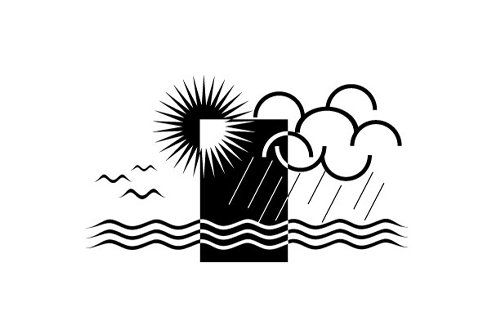
Forces of Nature
Wave Forces
1998
While naval architects had determined forces on ships by developing empirical formulae, no such experience was available to apply to the platforms and unusual structures which would be used for offshore development. Basic theoretical studies were undertaken together with experiments in the Gulf of Mexico to determine the loads that would arise from waves acting on the structures. The Oceanography Department of Texas A & M University, sponsored by Shell, Chevron, Humble Oil & Refining Co. and others, made field measurements to determine wave forces on a vertical cylinder and compared the results to analytical methods in the early 1950's. R. O. Reid, and C. L. Bretschneider played major roles in developing this technology. The work of W. H. Munk was used in the early design of platforms. Munk's formulae included the drag portion of the wave force. Later, the inertial components were included thanks to the work of J. R. Morison in the 1950s.
Recognizing the pioneering efforts of the following people and companies who contributed to the development of this technology:
Leon E. Borgman, Charles L. Bretschneider, J. R. Morison, Walter H. Munk, Robert O. Reid, Chevron (ChevronTexaco), Humble Oil & Refining Co. (ExxonMobil), Shell, Texas A & M University, University of California (Berkeley)
Wind, Wave & Current Hindcasting
1998
In order to determine the forces on a structure, engineers needed some way to determine the highest extreme values of wind, wave, and current in the life of the structure. In 1954 Chevron installed 3 separate pilings (from platform deck to ocean bottom) with devices to measure wave forces, wave velocities and wave heights. Humble Oil & Refining Co. contributed by analyzing the gathered data from these test installations in the Gulf of Mexico (1955-1962) and derived environmental design criteria for the maximum design storm or hurricane data for coastal and offshore regions along the Texas-Louisiana and California coasts. This resulted in specifications for the important characteristics of the complex design waves including wave height, length, period, and harmonic composition. A. H. Glenn used these formulae together with shore-based wind measurements and ship observations to provide the industry with the 100-year expected storm data at worldwide locations. Shell Oil and others pioneered methods for measurement of hurricane conditions far offshore in Hurricane Camille (1969). These data enabled development and calibration of modern numerical hindcast models. R. G. Bea led much of Shell's effort to develop criteria for wave forces and current conditions in the Gulf of Mexico for use with the American Petroleum Institute's (API) Recommended Practices for design. V. J. Cardone, W. J. Pierson and E. G. Ward were behind the development of later hindcast models.
Recognizing the pioneering efforts of the following people and companies who contributed to the development of this technology:
Robert G. Bea, C. Paul Besse, Sr., Charles L. Bretschneider, Vincent J. Cardone, Alfred H. "Al" Glenn, Willard J. Pierson, Emmett G. "Skip" Ward, Chevron (ChevronTexaco), Humble Oil Refining Co. (ExxonMobil), Magnolia Petroleum (ExxonMobil), Shell
Offshore Foundation Design
2001
In the early days of the industry it was important to develop reliable foundation designs for offshore structures. McClelland Engineers, Inc. pioneered the application of soil mechanics and foundation engineering (now called geotechnical engineering) for the foundation design for both fixed and mobile offshore platforms.
First it was necessary to determine the composition of the seafloor. The first marine soil mechanics boring was performed in August 1947 for the California Co. in 22 feet of water at a proposed platform site offshore Louisiana. It was drilled by a conventional land rig placed on a small platform designed and fabricated by McClelland Engineers. In the next six years about twenty similar borings were done along the Texas/Louisiana coastline. In 1953, Robert Perkins developed the technique of drilling from an anchored barge with a land rig cantilevered over the side.
In 1962, wireline sampling in uncased boreholes was introduced and became a cost effective procedure for conducting geotechnical investigations in deep water. In 1966, the remote vane was developed to make in situ measurements of clay shear strength from floating vessels.
In addition to determining the consistency of foundation materials, the technical contributions to the design of offshore foundations by McClelland Engineers were equally pioneering. In 1953, Bramlette McClelland and John Focht made landmark analyses of lateral load tests on offshore piles resulting in an ASME paper titled, "Soil Mechanics Applied to Mobile Drilling Structures". In 1956, they introduced the concept of limiting skin friction of stiff clays for driven piles, and they proposed the technique, now known as the "p-y concept", for the analysis of laterally loaded piles. API RP2A reflects their research on the tensile capacity of driven and jetted piles in sand. During the 60s, they developed comprehensive criteria for predicting capacity of driven and grouted single piles or circular pile groups in sands and soft marine clays. This program was paralleled by research on clay shear strength as influenced by different sampling and testing methods.
Recognizing the pioneering efforts of the following individuals and companies who contributed to the development of this technology:
John A. Focht, Jr., Bramlette McClelland, and Robert L. Perkins
McClelland Engineers, Inc. (Fugro-McClelland Marine Geosciences, Inc.)
The National Hurricane Center
2003
Weather, particularly severe weather, has been a concern to the offshore oil and gas industry since the beginning. From the first offshore operations in 1948, thousands of structures, both permanent and temporary, have been sited on the continental shelf and slope. At the same time an immense supply and support infrastructure has blossomed along the Gulf Coast from Mobile to Brownsville. Thousands of oilfield workers make their homes there, and the investment in structures, facilities, and equipment amounts to billions of dollars. All are at the mercy of wind, rain and tides.
The National Hurricane Center (NHC) is charged with the responsibility of safeguarding life and property by providing the most timely and reliable warnings of actual and potential tropical storm activity to agencies and governments charged with public safety. Accordingly, the NHC plays a vital role in keeping the offshore industry informed so they can implement safety procedures, evacuate workers, and protect equipment and the environment efficiently and cost-effectively.
The accurate forecasts of storm intensity, size and forward motion allow affected populations to implement predesigned plans to prepare for the storm in an orderly, prioritized way. This is most evident in the offshore oil industry, where storm preparedness is carefully staged to provide maximum protection for workers both offshore and on land, as well as for their equipment and facilities. Unfortunately, many of the lessons came at a high price, and storms such as Betsy, Carla, and Audrey are still remembered for their devastating effect on the industry, as well as the coastal communities.
Then, the industry was unprepared, but today, thanks to the work of the NHC, these unfortunate results are but a fading memory. It is a tribute to the skill and dedication of the NHC workers that, due to the steadily improved quality, accuracy and timeliness of their predictions, the offshore oil and gas industry has been able to persevere, exploring farther and farther from shore in deepening waters, confident that they will have the weather information they need to proceed safely.
Recognizing the pioneering efforts of the following organization that contributed to the development of the offshore industry:
The National Hurricane Center/Tropical Prediction Center
Wind, Wave and Current Hindcasting
2007
In order to determine the forces on a structure, engineers needed some way to determine the highest extreme values of wind, wave, and current in the life of the structure. In 1954 Chevron installed 3 separate pilings (from platform deck to ocean bottom) with devices to measure wave forces, wave velocities and wave heights. Humble contributed by analyzing the gathered data from these test installations in the Gulf of Mexico (1955-1962) and derived environmental design criteria for the maximum design storm or hurricane data for coastal and offshore regions along the Texas-Louisiana and California coasts. This resulted in specifications for the important characteristics of the complex design waves including wave height, length, period, and harmonic composition. A. H. Glenn used these formulae together with shore based wind measurements and ship observations to provide the industry with the 100-year expected storm data at worldwide locations. Shell Oil and others pioneered methods for measurement of hurricane conditions far offshore in Hurricane Camille (1969). These data enabled development and calibration of modern numerical hindcast models. R.G. Bea led much of Shell’s effort to develop criteria for wave conditions and forces in the Gulf of Mexico for use with the American Petroleum Institute's (API) Recommended Practices for design. V.J. Cardone, W.J. Pierson and E.G. Ward were behind the developments of later hindcast models.
Recognizing the pioneering efforts of the following individuals and companies who contributed to the development of this technology:
Robert G. Bea, C. Paul Besse, Sr., Charles L. Bretschneider, Vincent J. Cardone, John C. Freeman, Alfred H. "Al" Glenn, Willard J. Pierson, Emmett G. "Skip" Ward
Chevron, Humble Oil & Refining Co. (now ExxonMobil), Magnolia Petroleum (now ExxonMobil), Shell
The DeepStar Project
2010
With Leases in the Gulf of Mexico going into deeper water and farther from shore, Texaco in 1991 understood that significantly more technology and knowledge would be required to explore and produce these reservoirs successfully. With Curtis Burton and Steven Wheeler taking the leadership role, Texaco started the initial framing studies with Intec Engineering and evolved the concept that the industry as a whole would benefit more by doing it together. Texaco then took the concept to industry by selling “shares” in projects which became known as “The DeepStar Project” that is currently managed by Chevron.
Membership grew to 26 Operating companies by the mid 1990s with technology studies strongly influencing successful developments in the Gulf of Mexico, and from there, the technology has translated around the world. Since its start, The DeepStar Project has performed over 300 technical studies and initiatives categorized in 9 different technical areas that include Geosciences, Regulatory, Flow Assurance, Subsea Facilities, Surface Facilities, Drilling and Completion, Reservoir Engineering, Metocean and System Engineering. To keep the program fresh and relevant every 2 years new and diverse projects are added.
Projects now feature operations in over 10,000 ft water depth and include both dry Christmas tree production and pressure boosting subsea production that will allow satellite fields from 50 miles away to successfully produce. Today over 1,800 industry personnel are active in the program with operators, contractors and service companies contributing, monitoring and communicating via The DeepStar Project website and meetings.
Recognizing the pioneering efforts of the following individuals and early companies who participated in the development of the first phase of the DeepStar Project:
Joe Albiez, Tom Ames, Charles Balnaves, Bill Beran, Irving Brooks, Curtis Burton, Jim Chitwood, John Illeman, Clive Llewellyn, Doug Peart, Bob Rayne, George Vance, Steve Wheeler,
Carl Wickizer, Phil Wilbourn, BHP (now BHP Billiton Petroleum), BP, Chevron, Conoco (now ConocoPhillips), Elf (now TOTAL), Exxon (now ExxonMobil), Intec Engineering (now INTECSEA), Marathon Oil Company (now Marathon Oil Corporation), Mobil Oil (now ExxonMobil), Oryx Energy (now Anadarko), Texaco (now Chevron), and Shell Oil Co.
University, University of California (Berkeley)




